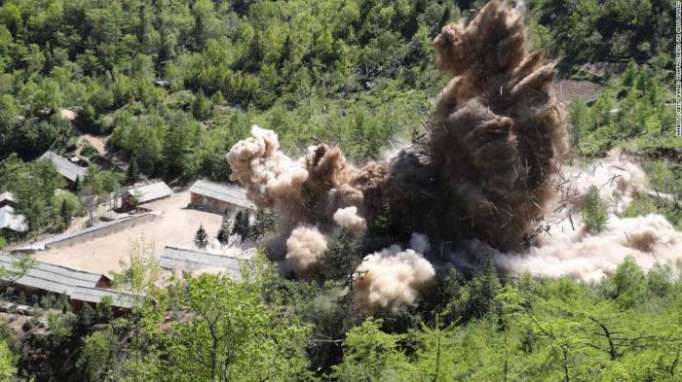We were back on our Soviet style soft sleeper carriage on the way back from the destruction of the Punggye-ri nuclear test site, when the call came through from CNN that US President Donald Trump had called off the planned summit with North Korean leader Kim Jong Un.
The North Koreans on the train learned the news from us. They were shocked and crestfallen.
In their eyes, Pyongyang had just gone through with a major show of good faith in destroying its primary nuclear site, only to have Washington cancel a summit North Korea has been hoping to hold for decades.
Uncertain beginnings
Even after we first arrived in Wonsan on Tuesday, it seemed like trip to Punggye-ri still might not happen, with Pyongyang and Washington trading angry barbs, and rumblings the Singapore summit could be called off.
Things started looking brighter however: a number of South Korean journalists initially denied permission to enter the country received their visas at the last minute and flew from Beijing to join us at the luxurious marbled hotel we'd been put up in.
Finally, late into Wednesday afternoon, we were told to prepare to leave, and soon we boarded a bus to the train station.

Journalists film the Punggye-ri nuclear site after the tunnels are detonated.
A 10-carriage train had been specially arranged for the trip. Two sleeper carriages for the journalists and minders and a restaurant car were all that we were allowed to explore. It was unclear whether anyone else was in the remaining carriages.
The sleeping carriages were old fashioned but cosy and clean, but there was one detail that seemed strange: although it was still bright afternoon, all the blinds in the corridors and compartments were closed. When we naturally opened them, we were told to shut them again: there was to be no filming -- or looking out of the window -- for the roughly 12-hour trip.
Of all the hundreds of journalists that had asked to be on this trip, North Korea accepted only a small group, a little over two dozen in total, representing two media outlets each from the US, Russia, China, the UK and South Korea.
Not a single print or radio journalist among them -- for Pyongyang, this was about images above all else.
After a sumptuous, 10-course dinner in a luxury dining car, we retired to our sleeping compartments. At some point in the night, the train stopped for several hours and guards walked along the corridors.
Finally, early on Thursday morning, the blinds were lifted so we could see, and film, the countryside we were passing through. Soon enough however, we were ordered to stop filming again as we reached the train station and boarded buses to the nuclear site itself.
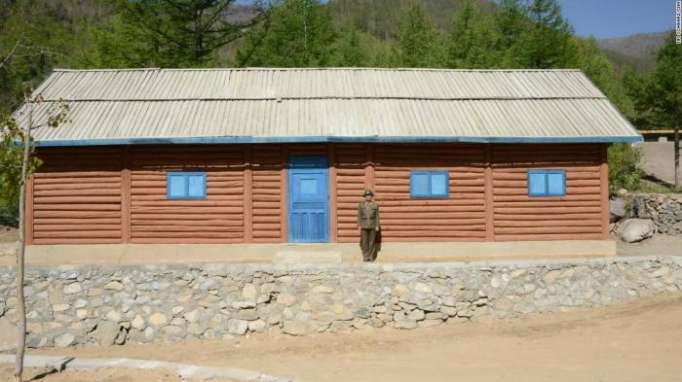
The site at Punggye-ri looked bizarrely like an old fashioned holiday camp, with wooden log cabins.
Route to Punggye-ri
After a 90-minute drive along a rough dirt road into the mountains, we passed several small villages.
These were obviously occupied, because the fields had been recently cultivated and the buildings were in good repair, but not a soul was in sight. There were no animals, no children, not even a bicycle propped against a wall, and in every house we could see from the road, the curtains were drawn.
The only people we saw on the entire drive to the nuclear site were soldiers manning the few checkpoints we passed through.
Punggye-ri itself looked bizarrely like a holiday camp, with large log cabins scattered around a clearing in the woods. We were told strictly not to try and go inside any of the buildings, because they were all rigged with explosives.
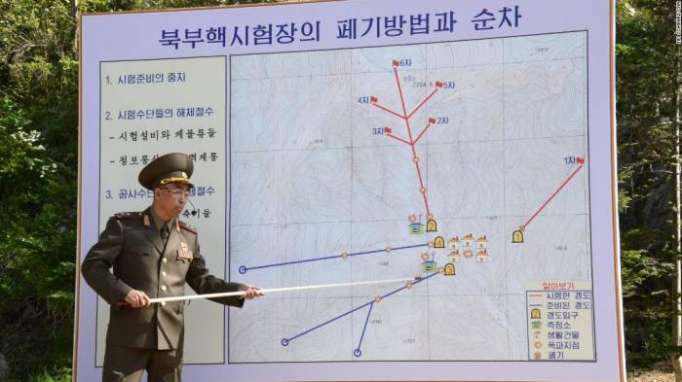
An official, identified only as the Deputy Director of North Korea's Nuclear Institute, briefs reporters before the detonations.
After a briefing from the Deputy Director of North Korea's Nuclear Institute in front of a giant map of the nuclear site, we were able to inspect the testing tunnels themselves.
The oldest tunnel on the site had already been collapsed some years earlier, but three tunnels were intact, and the North Korean officials accompanying us said two of the tunnels had never been used, and could have easily conducted future nuclear tests.
This was difficult to judge -- no experts or inspectors had been allowed on the trip despite initial suggestions they would be, only journalists -- but the tunnels appeared to be in good order, timbered inside like an old Wild West gold mine.
Also inside, stretching as far as the eye could see, were bundles of wires and detonation charges to prepare for the tunnels' imminent destruction.
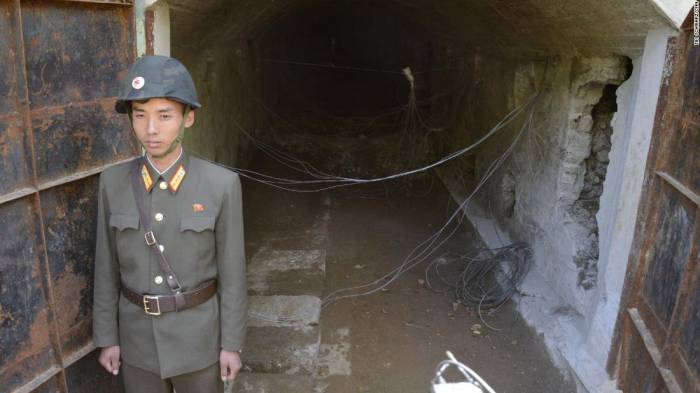
Inside the tunnels, bundles of explosives could be seen rigged to blow.
Detonation and disappointment
Finally, the time had come, and we donned bright yellow safety helmets and, tailed by medics in case one of us sprained an ankle or was hit by debris, we trooped up to an observation deck to watch the first tunnel's detonation.
With a colossal bang and a burst of earth, smoke and dust, tunnel #2 exploded outwards in a cloud of rubble. The earth under our feet shook as the buildings next to the tunnel were also detonated.
Once the smoke had cleared, we were taken to inspect the aftermath. All that remained of the buildings was splintered wood, we could see that there had been no equipment of any kind in the huts, anything that was previously there had been removed.
After an al fresco lunch of ham and cucumber sandwiches in the shade of camouflage netting, during which we were again warned to stay away from the buildings either side because they too were rigged with explosives, we headed up the hill again to another observation point to watch the destruction of tunnels #3 and #4.
Finally, the Deputy Director read us another prepared statement, informing us that the exercise was a success and the facilities had been completely destroyed.
Some North Koreans around us did not look exactly pleased. For many of them, they were witnessing the destruction of decades of work.
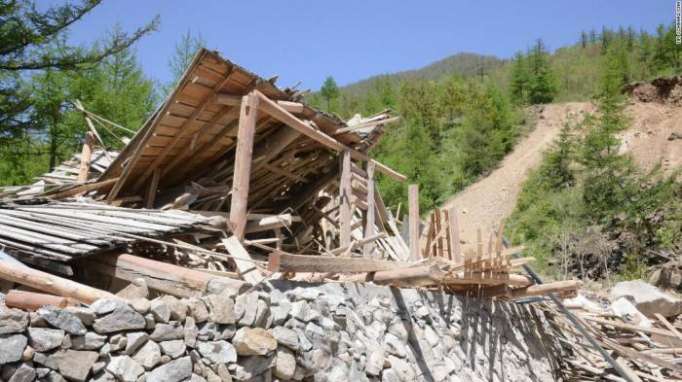
All that was left off the entrance to tunnel #2 after the explosion.
Others were happier however, sure that this was a step in a positive direction, an historic moment that would soon be overshadowed by the meeting between Kim and Trump, the first ever between a North Korean leader and sitting US President.
Those good feelings were quickly dashed by Trump's letter to Kim, in which he expressed a willingness to meet in future, but said the planned Singapore summit would be "inappropriate, at this time."
Despite fears a collapse in talks could see a return to "fire and fury," North Korea seems willing to press on with diplomacy. In a response to Trump published early Friday, a top official said "we are willing to sit face to face at any time and in any way."
"I would like to conclude that President Trump's statement on the North Korea-US summit is a decision that is not in line with the wishes of the who hope for the peace and stability of the Korean peninsula as well as the world," he said.
Read the original article on CNN.
More about: nuclear








